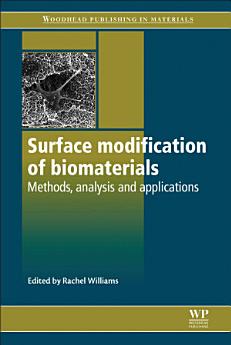Surface Modification of Biomaterials: Methods Analysis and Applications
Rachel Williams
Nov 2010 · Elsevier
3.0star
1 reviewreport
Ebook
432
Pages
family_home
Eligible
info
reportRatings and reviews aren’t verified Learn More
About this ebook
The surface modification of biomaterials plays a significant role in determining the outcome of biological-material interactions. With the appropriate modification a material's surface can be tailored to improve biocompatibility, adhesion and cell interactions. Consequently surface modification is vital in the development and design of new biomaterials and medical devices. Surface modification of biomaterials reviews both established surface modifications and those still in the early stages of research and discusses how they can be used to optimise biological interactions and enhance clinical performance.Part one begins with chapters looking at various types and techniques of surface modification including plasma polymerisation, covalent binding of poly (ethylene glycol) (PEG), heparinisation, peptide functionalisation and calcium phosphate deposition before going on to examine metal surface oxidation and biomaterial surface topography to control cellular response with particular reference to technologies, cell behaviour and biomedical applications. Part two studies the analytical techniques and applications of surface modification with chapters on analysing biomaterial surface chemistry, surface structure, morphology and topography before moving onto discuss modifying biomaterial surfaces to optimise interactions with blood, control infection, optimise interactions with soft tissues, repair and regenerate nerve cells, control stem cell growth and differentiation and to optimise interactions with bone.The distinguished editor and international team of contributors to Surface modification of biomaterials have produced a unique overview and detailed chapters on a range of surface modification techniques which will provide an excellent resource for biomaterials researchers and scientists and engineers concerned with improving the properties of biomaterials. It will also be beneficial for academics researching surface modification. - Reviews both established surface modifications and those still in the early stages of research and how they can be used to optimise biological interactions and enhance clinical performance - Studies analytical techniques and applications of surface modification with chapters assessing biomaterial surface chemistry, surface structure, morphology and topography - Discusses modifying biomaterial surfaces to optimise interactions with blood and soft tissues and also to repair and regenerate nerve cells and control infection
Ratings and reviews
3.0
1 review
About the author
Dr Rachel Williams is a reader in clinical engineering at the University of Liverpool, UK. She is well regarded for her biomaterials research particularly her work on ophthalmic biomaterials.
Rate this ebook
Tell us what you think.
Reading information
Smartphones and tablets
Install the Google Play Books app for Android and iPad/iPhone. It syncs automatically with your account and allows you to read online or offline wherever you are.
Laptops and computers
You can listen to audiobooks purchased on Google Play using your computer's web browser.
eReaders and other devices
To read on e-ink devices like Kobo eReaders, you'll need to download a file and transfer it to your device. Follow the detailed Help Center instructions to transfer the files to supported eReaders.








